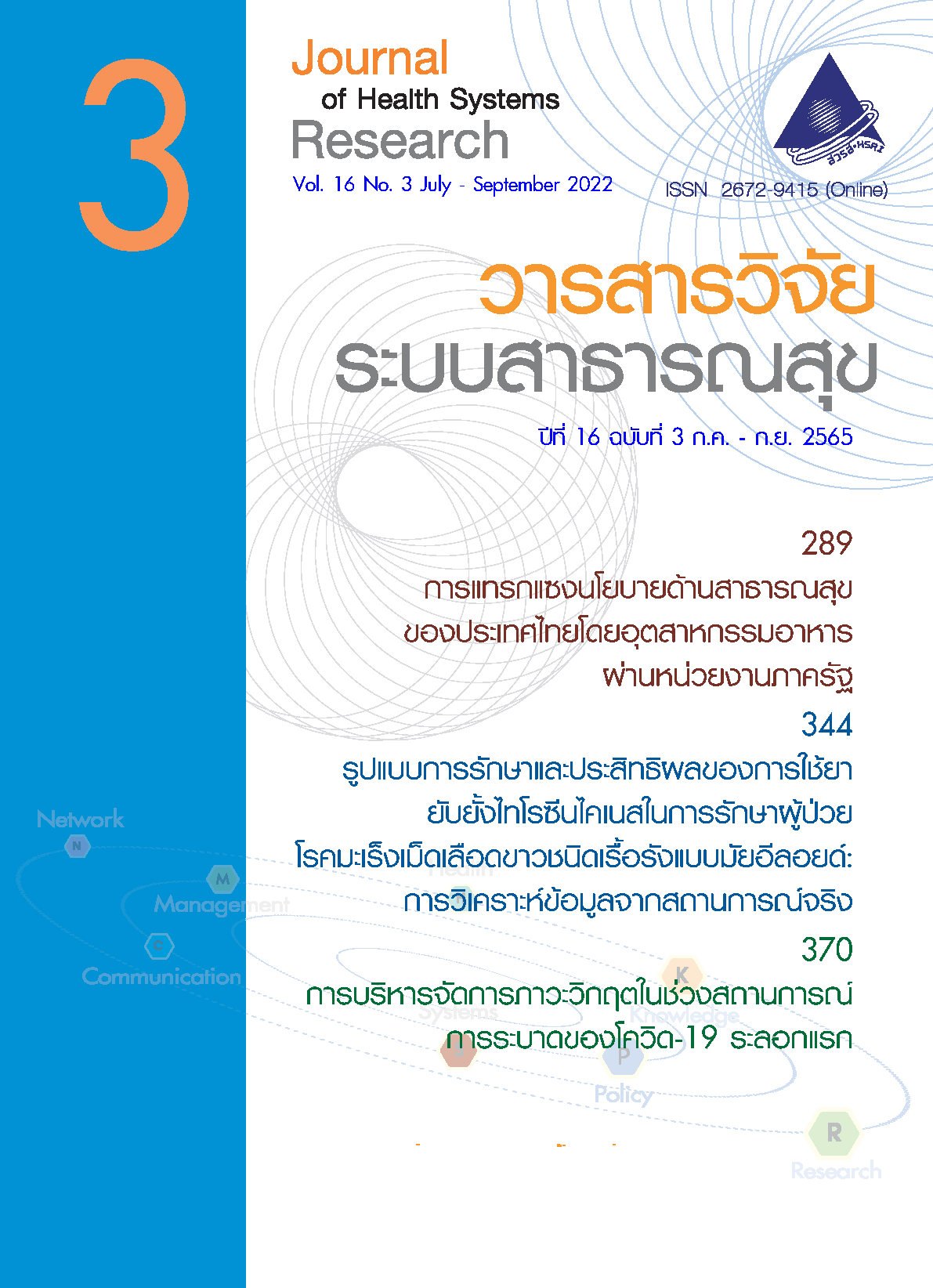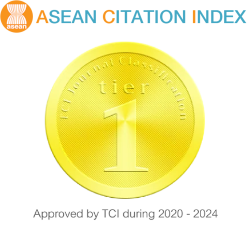การพัฒนารูปแบบการขับเคลื่อนการใช้สัญลักษณ์โภชนาการ “ทางเลือกสุขภาพ” เพื่อการสร้างเสริมสุขภาพของผู้บริโภคในร้านก๋วยเตี๋ยว ภายในอําเภอเมืองลําปาง
คำสำคัญ:
ทางเลือกสุขภาพ, สัญลักษณ์โภชนาการ, เกลือโซเดียม, ร้านก๋วยเตี๋ยวบทคัดย่อ
การวิจัยและพัฒนาครั้งนี้มีวัตถุประสงค์เพื่อ 1) พัฒนารูปแบบ และ 2) ศึกษาประสิทธิผลการใช้สัญลักษณ์โภชนาการทางเลือกสุขภาพในร้านก๋วยเตี๋ยว อําเภอเมืองลําปาง จังหวัดลําปาง ประกอบด้วย 4 ขั้นตอน 1) วิเคราะห์ ประเมินความต้องการโดยสัมภาษณ์เชิงลึกผู้ที่เกี่ยวข้อง (R1) 2) ออกแบบ พัฒนารูปแบบด้วยการปรับสูตรน้ำซุปก๋วยเตี๋ยวโดยใช้เครื่องปรุงที่มีปริมาณเกลือโซเดียมลดลงแทนเครื่องปรุงรสเดิม (D1) 3) ทดลองใช้รูปแบบกับผู้ประกอบการเป็นระยะเวลา 3 เดือน ด้วยการปรับสูตรน้ำซุป วิธีปรุงน้ำซุป การวัดปริมาณเกลือโซเดียมในน้ำซุป การจัดวางเครื่องปรุงที่มีสัญลักษณ์ทางเลือกสุขภาพในร้าน (R2) และประเมินความรู้ ทัศนคติและพฤติกรรมเรื่องสัญลักษณ์ทางเลือกสุขภาพ วัดปริมาณการใช้เกลือโซเดียมในระยะเวลาต่างๆ ประเมินความพึงพอใจโดยเลือกกลุ่มตัวอย่างผู้ประกอบการแบบเฉพาะเจาะจง 16 คน เก็บรวบรวมข้อมูลโดยใช้แบบสอบถาม แบบสัมภาษณ์เชิงลึก 4) ประเมินผลจากความรู้ ทัศนคติ พฤติกรรม ปริมาณการใช้เกลือโซเดียม ความพึงพอใจหลังได้รับการพัฒนามาปรับปรุงในประเด็นของสูตรน้ำซุปให้เหมาะสม (D2) ด้วยการวิเคราะห์เชิงเนื้อหาจากการสนทนากลุ่ม
ผลการศึกษา พบว่า ขั้นตอน 1 ผู้ประกอบการเห็นความจําเป็นในการปรับลดการใช้เกลือโซเดียมในน้ำซุป ขั้นตอน 2 เกิดการพัฒนาสูตรน้ำซุปด้วยการใช้ซีอิ๊วขาวที่มีสารโพแทสเซียมคลอไรด์ทดแทนเกลือโซเดียมเดิม มีคู่มือปฏิบัติ คือ แนวทางปรับสูตร วิธีปรุงน้ำซุป การวัดตวงปริมาณเกลือโซเดียม การจัดวางเครื่องปรุงในร้าน ขั้นตอน 3 ผลการใช้สูตรน้ำซุป ผู้ประกอบการมีความรู้ ทัศนคติและพฤติกรรมที่ดีเพิ่มขึ้น ปริมาณการใช้เกลือโซเดียมลดลง มีความพึงพอใจในระดับมากที่สุด ขั้นตอน 4 ผลการประเมิน พบปริมาณการใช้เกลือโซเดียมลดลงจากการวัดตวงแต่ละวัน แต่ผลการศึกษายังเป็นเพียงการศึกษานําร่องที่มีกลุ่มตัวอย่างน้อยควรขยายผลการใช้รูปแบบไปยังประชากรที่มีขนาดใหญ่ขึ้นเพื่อให้ได้ผลที่น่าเชื่อถือต่อไป
เอกสารอ้างอิง
Pitisutti S. Acceptance of social media to improve street food business in the Bangkok metropolitan area. An independent study submitted in partial fulfillment of the requirement for the degree of master of business administration, faculty of commerce and accountancy. Bangkok: Thammasat University; 2018.
Apinya T. Strategy to reduce salt and sodium consumption in Thailand 2016-2025. Bangkok: War Veterans Organization of Thailand under royal patronage; 2016.
Kerdphoka P. Situation of health problems of Thai people from consuming salt (sodium). 2019 [cited 2019 Apr 30]. Available from: https://oryor.com/media/infoGraphic/media_printing/1767. (in Thai)
Mekhora C, Vattanasuchart N. Sodium reduction: health role, strategy and research for food product reformulation. Journal of Nutrition Association of Thailand. 2020;55(1):111-30.
Thai Health Reform Foundation. Thai people are addicted to salt from local culture. cause more than 20,000 deaths per year. 2019. [cited 2019 Mar 20]. Available from: https://www.hfocus.org/content/2019/04/17106. (in Thai)
Consumer Protection Group, Lampang Provincial Public Health Office. Interview report of entrepreneur noodle shop in Lampang province. Lampang: Provincial Public Health Office; 2020.
Clark D. Instructional system design-analysis phase. Computing in Childhood Education 2003;1:3-27.
Best W. and Kahn V. Research in education. 8th Edition. Chicago: Butler University, Emeritus, University of Illinois; 1998.
Creswell JW. Research design: qualitative, quantitative, and mixed methods approaches. 4th ed. Thousand Oaks, California: SAGE Publications; 2014.
Thai Health Promotion Foundation. Development and promotion project, simple nutrition symbol. 2016 [cited 2016 Dec 13]. Available from: http://healthierlogo.com. (in Thai)
Mekhora C, Vattanasuchart N. Sodium reduction: health role, strategy and research for food product reformulation. Journal of Nutrition Association of Thailand. 2020;55(1):111-30. (in Thai)
Grummer J, Bobowski N, Karalus M, Vickers Z, Schoenfuss T. Use of potassium chloride and flavor enhancers in low sodium Cheddar cheese. J Dairy Sci. 2013;96(3):1401-18.
Horita CN, Esmerino EA, Vidal VAS, Farah JS, Amaral GV, Bolini HMA, et al. Sensory profiling of low sodium frankfurter containing garlic products: adequacy of polarized projective mapping compared with trained panel. Meat Sci. 2017;131:90-8.
Paulsen MT, Nys A, Kvarberg R, Hersleth M. Effects of NaCl substitution on the sensory properties of sausages: temporal aspects. Meat Sci. 2014;98(2):164-70.
Wu H, Zhang Y, Long M, Tang J, Yu X, Wang J, et al. Proteolysis and sensory properties of dry-cured bacon as affected by the partial substitution of sodium chloride with potassium chloride. Meat Sci. 2014;96(3):1325-31.
Rodrigues JF, Goncalves CS, Pereira RC, Carneiro JD, Pinheiro AC. Utilization of temporal dominance of sensations and time intensity methodology for development of low-sodium mozzarella cheese using a mixture of salts. J Dairy Sci. 2014;97(8):4733-44.
Ma GX, Shive S, Zhang Y, Aquilante J, Tan Y, Zhao M,et al. Knowledge, perceptions, and behaviors related to salt use among Philadelphia Chinese take-out restaurant owners and chefs. Health Promotion Practice. 2014;15(5):638-45.
Suon M, Ruaisungnoen W. Health literacy on sodium restriction and associated factors among patients with hypertension in Phnom Penh, Cambodia. Nursing Science Journal of Thailand. 2019;37(4):32-41. (in Thai)
Bureau of Non-Communicable Diseases, Department of Disease Control, Ministry of Public Health. Strategy to reduce salt and sodium consumption in Thailand 2016-2025. Bangkok; 2016 [cited 2019 Jan 5 ]. Available from: https://thaidj.org/index.php/jdhss/article/view/6310.
Escaron AL, Martinez-Donate AP, Riggall AJ, Meinen A, Hall B, Nieto FJ, et al. Developing and Implementing “Waupaca Eating Smart”: a restaurant and supermarket intervention to promote healthy eating through changes in the food environment. Health Promotion Practice. 2016;17(2):265-77.
Chau PH, Leung AYM, Li HLH, Sea M, Chan R, Woo J. Development and validation of Chinese health literacy scale for low salt consumption - Hong Kong population (CHLSalt-HK). PLoS ONE. 2015:10(7):e0132303. doi: 10.1371/journal.pone.0132303.
ดาวน์โหลด
เผยแพร่แล้ว
รูปแบบการอ้างอิง
ฉบับ
ประเภทบทความ
สัญญาอนุญาต
ลิขสิทธิ์ (c) 2025 วารสารวิจัยระบบสาธารณสุข

อนุญาตภายใต้เงื่อนไข Creative Commons Attribution-NonCommercial-NoDerivatives 4.0 International License.
วารสารวิจัยระบบสาธารณสุขอยู่ภายใต้การอนุญาต Creative Commons Attribution-NonCommercial-NoDerivatives 4.0 International (CC BY-NC-ND 4.0) เว้นแต่จะระบุไว้เป็นอย่างอื่น



